Leadership and Management Practices in Healthcare Settings Essay
VerifiedAdded on 2023/01/03
|22
|4959
|26
Essay
AI Summary
This essay delves into the intricacies of leadership and management (L&M) practices within healthcare settings, specifically focusing on the influence of external drivers such as political instability, economic constraints, and technological advancements, alongside internal capabilities like leadership skills and decision-making processes. It evaluates the impact of cultural factors on leadership styles and the creation of interactive and safe healthcare environments. The essay further examines the role of leaders in managing the needs of patients' families, carers, and staff, while also addressing the effects of environmental factors on management decisions and the quality of care services. Using Anchor's Greenhive care home as a case study, the essay explores challenges like staffing issues, funding constraints, and the need for technological integration, emphasizing the importance of transformational and participative leadership styles to foster teamwork, improve communication, and adapt to changing healthcare demands. The analysis underscores the significance of identifying internal strengths, exploring opportunities, and mitigating threats to ensure sustainable development and high-quality patient care.
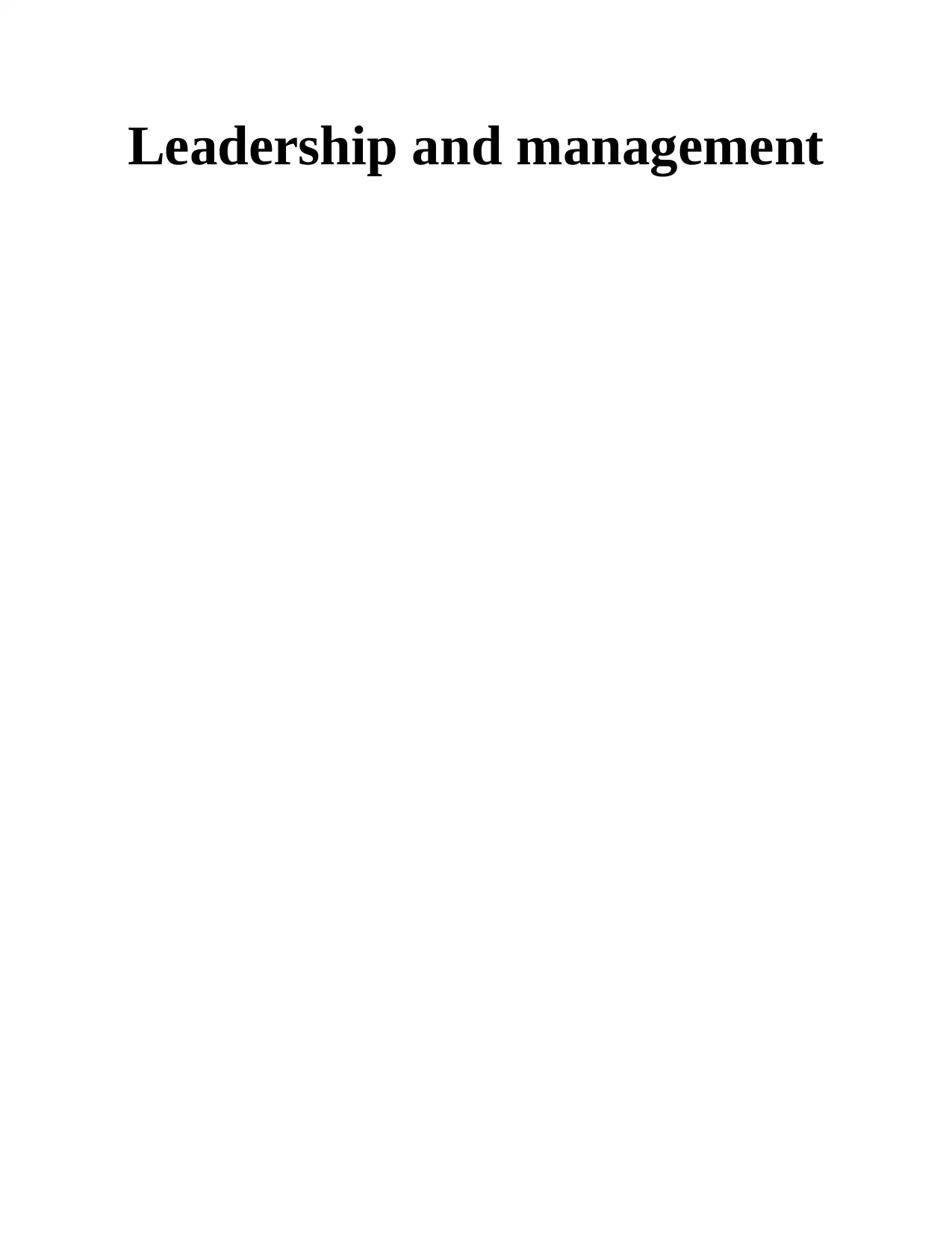
Leadership and management
Paraphrase This Document
Need a fresh take? Get an instant paraphrase of this document with our AI Paraphraser
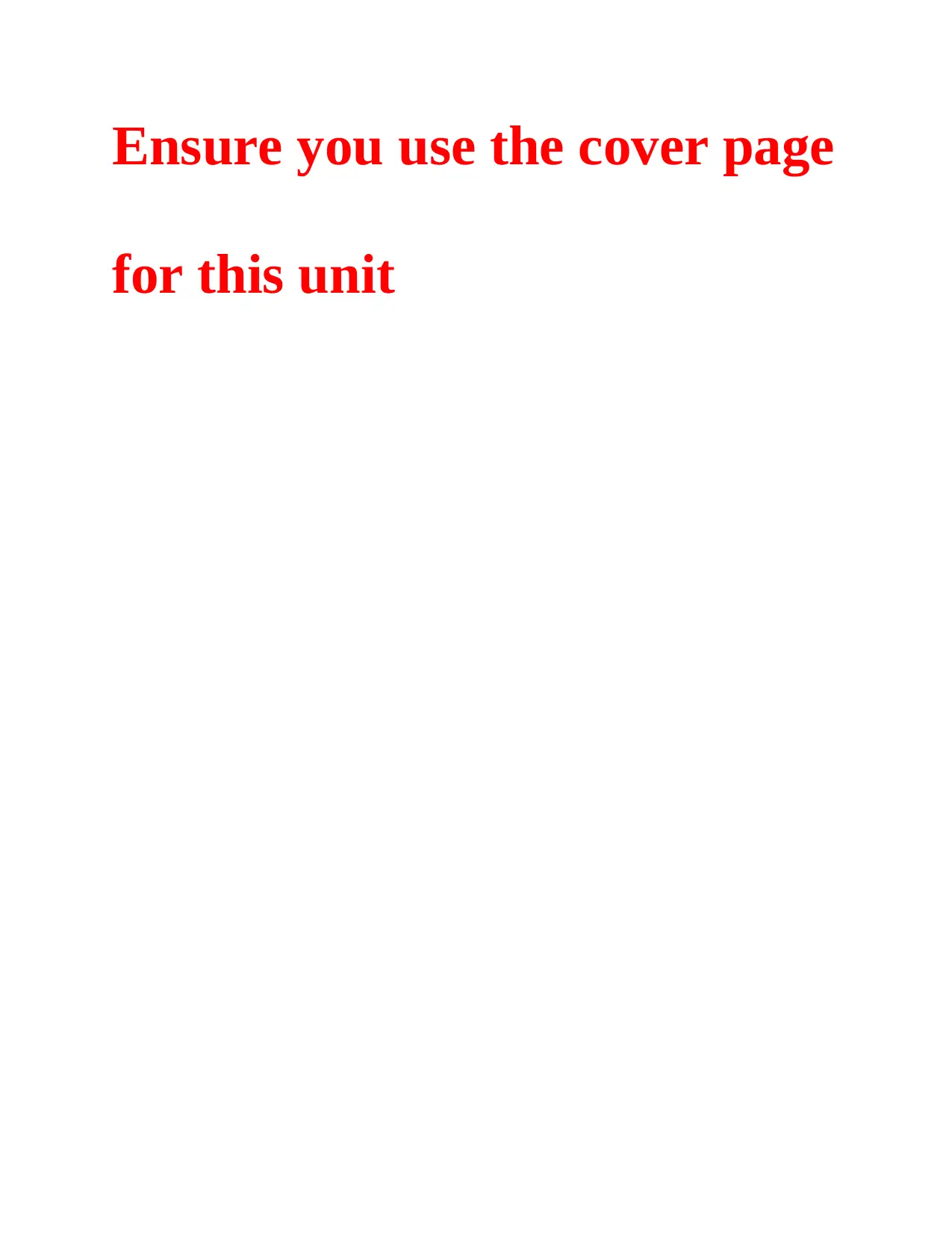
Ensure you use the cover page
for this unit
for this unit
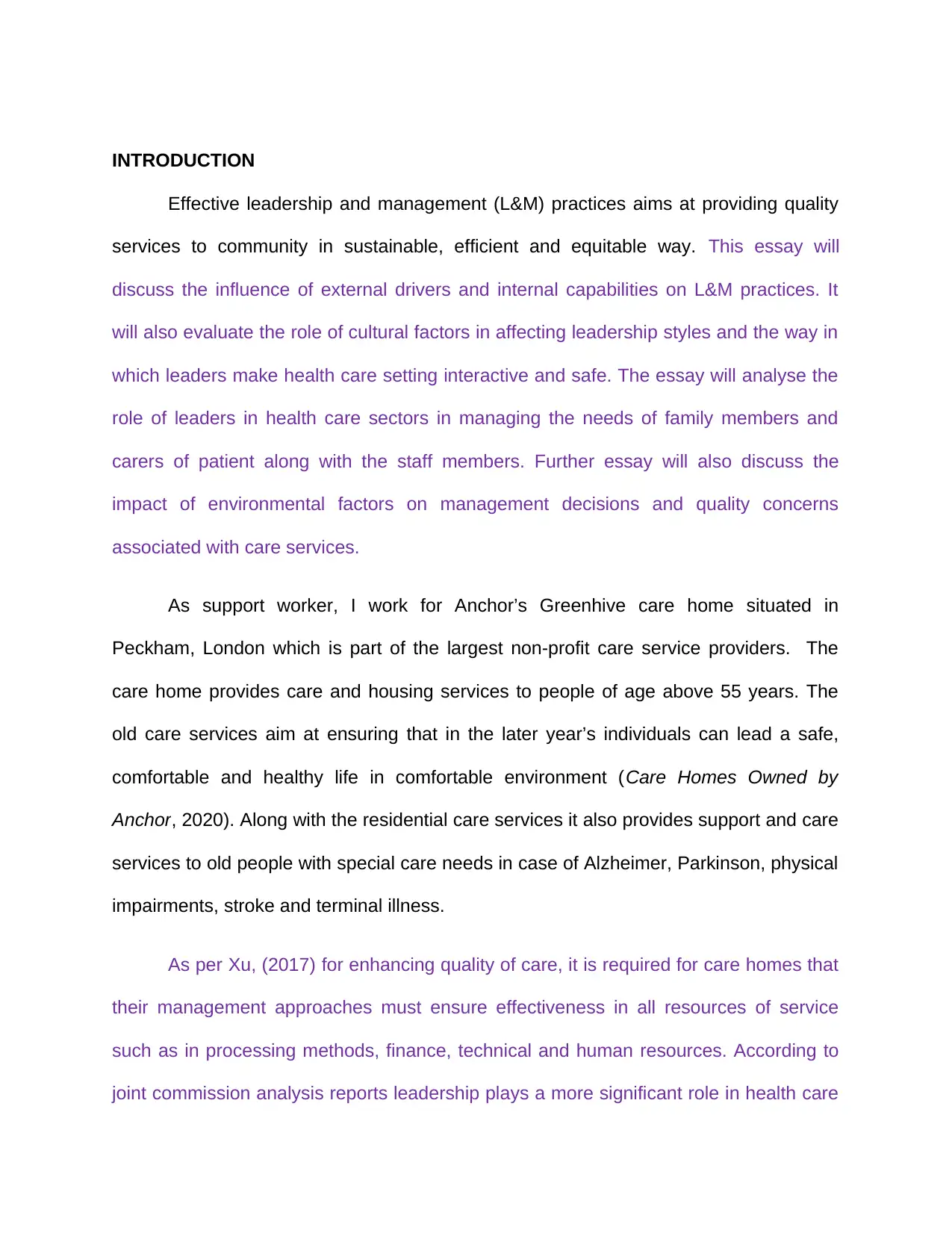
INTRODUCTION
Effective leadership and management (L&M) practices aims at providing quality
services to community in sustainable, efficient and equitable way. This essay will
discuss the influence of external drivers and internal capabilities on L&M practices. It
will also evaluate the role of cultural factors in affecting leadership styles and the way in
which leaders make health care setting interactive and safe. The essay will analyse the
role of leaders in health care sectors in managing the needs of family members and
carers of patient along with the staff members. Further essay will also discuss the
impact of environmental factors on management decisions and quality concerns
associated with care services.
As support worker, I work for Anchor’s Greenhive care home situated in
Peckham, London which is part of the largest non-profit care service providers. The
care home provides care and housing services to people of age above 55 years. The
old care services aim at ensuring that in the later year’s individuals can lead a safe,
comfortable and healthy life in comfortable environment (Care Homes Owned by
Anchor, 2020). Along with the residential care services it also provides support and care
services to old people with special care needs in case of Alzheimer, Parkinson, physical
impairments, stroke and terminal illness.
As per Xu, (2017) for enhancing quality of care, it is required for care homes that
their management approaches must ensure effectiveness in all resources of service
such as in processing methods, finance, technical and human resources. According to
joint commission analysis reports leadership plays a more significant role in health care
Effective leadership and management (L&M) practices aims at providing quality
services to community in sustainable, efficient and equitable way. This essay will
discuss the influence of external drivers and internal capabilities on L&M practices. It
will also evaluate the role of cultural factors in affecting leadership styles and the way in
which leaders make health care setting interactive and safe. The essay will analyse the
role of leaders in health care sectors in managing the needs of family members and
carers of patient along with the staff members. Further essay will also discuss the
impact of environmental factors on management decisions and quality concerns
associated with care services.
As support worker, I work for Anchor’s Greenhive care home situated in
Peckham, London which is part of the largest non-profit care service providers. The
care home provides care and housing services to people of age above 55 years. The
old care services aim at ensuring that in the later year’s individuals can lead a safe,
comfortable and healthy life in comfortable environment (Care Homes Owned by
Anchor, 2020). Along with the residential care services it also provides support and care
services to old people with special care needs in case of Alzheimer, Parkinson, physical
impairments, stroke and terminal illness.
As per Xu, (2017) for enhancing quality of care, it is required for care homes that
their management approaches must ensure effectiveness in all resources of service
such as in processing methods, finance, technical and human resources. According to
joint commission analysis reports leadership plays a more significant role in health care
⊘ This is a preview!⊘
Do you want full access?
Subscribe today to unlock all pages.

Trusted by 1+ million students worldwide
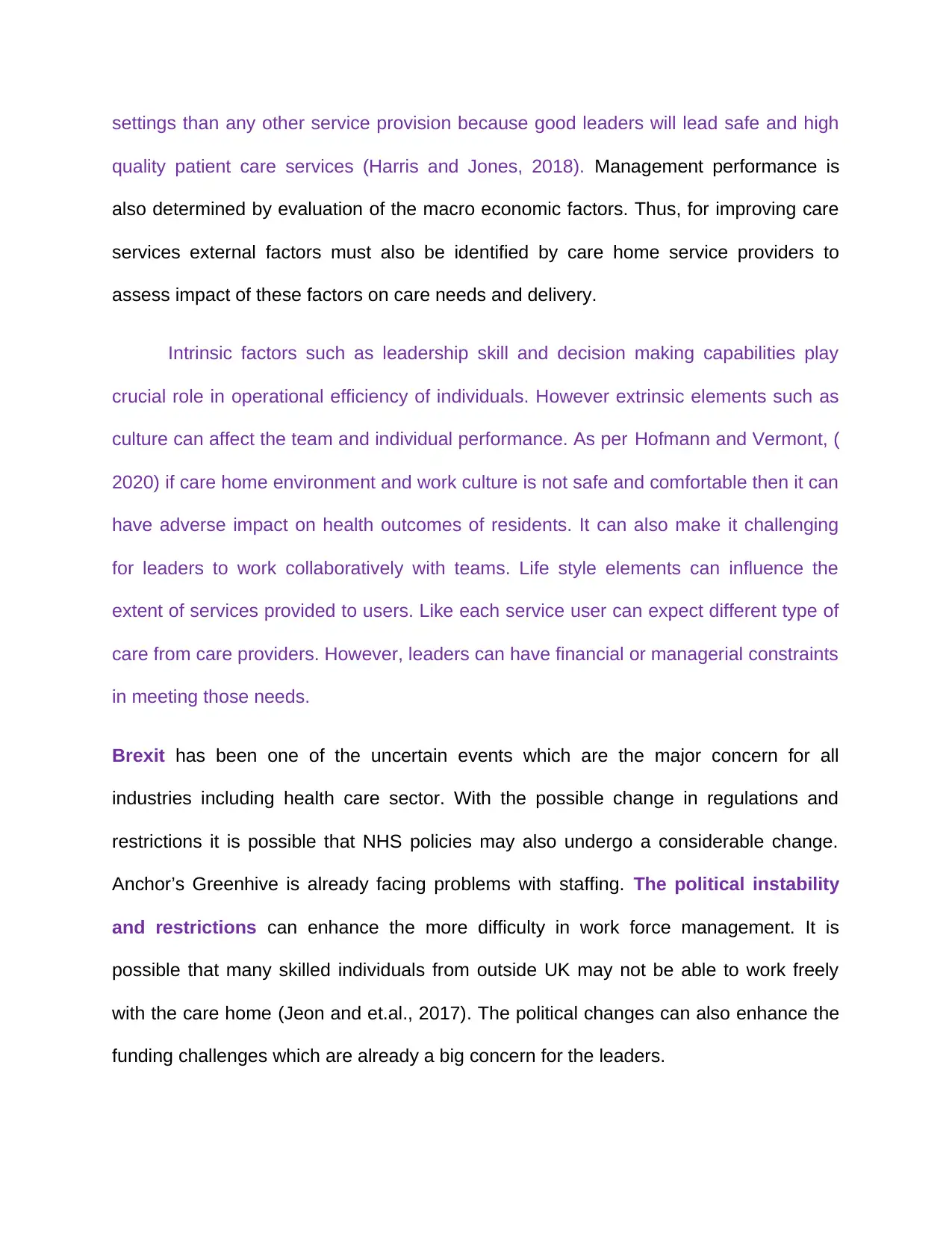
settings than any other service provision because good leaders will lead safe and high
quality patient care services (Harris and Jones, 2018). Management performance is
also determined by evaluation of the macro economic factors. Thus, for improving care
services external factors must also be identified by care home service providers to
assess impact of these factors on care needs and delivery.
Intrinsic factors such as leadership skill and decision making capabilities play
crucial role in operational efficiency of individuals. However extrinsic elements such as
culture can affect the team and individual performance. As per Hofmann and Vermont, (
2020) if care home environment and work culture is not safe and comfortable then it can
have adverse impact on health outcomes of residents. It can also make it challenging
for leaders to work collaboratively with teams. Life style elements can influence the
extent of services provided to users. Like each service user can expect different type of
care from care providers. However, leaders can have financial or managerial constraints
in meeting those needs.
Brexit has been one of the uncertain events which are the major concern for all
industries including health care sector. With the possible change in regulations and
restrictions it is possible that NHS policies may also undergo a considerable change.
Anchor’s Greenhive is already facing problems with staffing. The political instability
and restrictions can enhance the more difficulty in work force management. It is
possible that many skilled individuals from outside UK may not be able to work freely
with the care home (Jeon and et.al., 2017). The political changes can also enhance the
funding challenges which are already a big concern for the leaders.
quality patient care services (Harris and Jones, 2018). Management performance is
also determined by evaluation of the macro economic factors. Thus, for improving care
services external factors must also be identified by care home service providers to
assess impact of these factors on care needs and delivery.
Intrinsic factors such as leadership skill and decision making capabilities play
crucial role in operational efficiency of individuals. However extrinsic elements such as
culture can affect the team and individual performance. As per Hofmann and Vermont, (
2020) if care home environment and work culture is not safe and comfortable then it can
have adverse impact on health outcomes of residents. It can also make it challenging
for leaders to work collaboratively with teams. Life style elements can influence the
extent of services provided to users. Like each service user can expect different type of
care from care providers. However, leaders can have financial or managerial constraints
in meeting those needs.
Brexit has been one of the uncertain events which are the major concern for all
industries including health care sector. With the possible change in regulations and
restrictions it is possible that NHS policies may also undergo a considerable change.
Anchor’s Greenhive is already facing problems with staffing. The political instability
and restrictions can enhance the more difficulty in work force management. It is
possible that many skilled individuals from outside UK may not be able to work freely
with the care home (Jeon and et.al., 2017). The political changes can also enhance the
funding challenges which are already a big concern for the leaders.
Paraphrase This Document
Need a fresh take? Get an instant paraphrase of this document with our AI Paraphraser
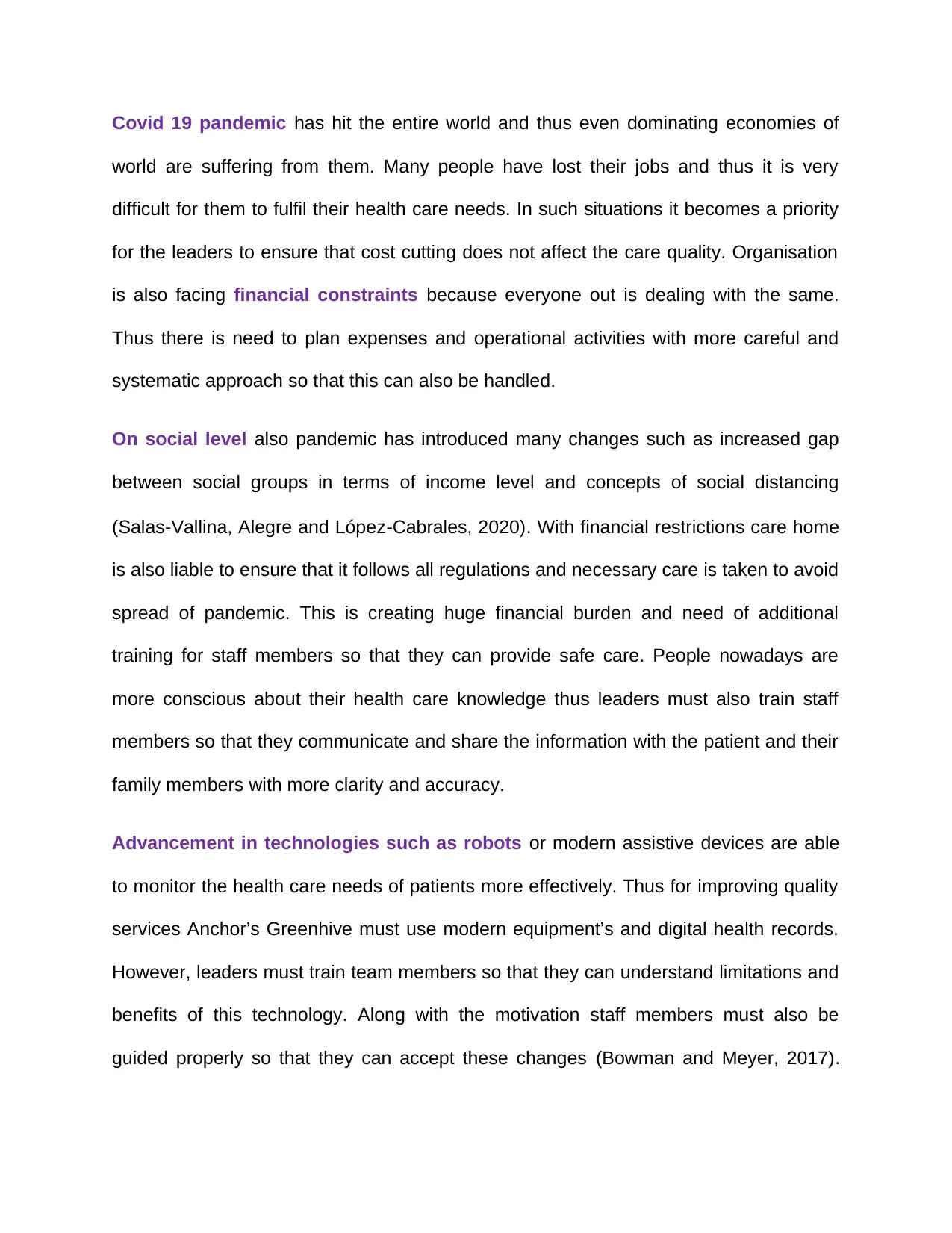
Covid 19 pandemic has hit the entire world and thus even dominating economies of
world are suffering from them. Many people have lost their jobs and thus it is very
difficult for them to fulfil their health care needs. In such situations it becomes a priority
for the leaders to ensure that cost cutting does not affect the care quality. Organisation
is also facing financial constraints because everyone out is dealing with the same.
Thus there is need to plan expenses and operational activities with more careful and
systematic approach so that this can also be handled.
On social level also pandemic has introduced many changes such as increased gap
between social groups in terms of income level and concepts of social distancing
(Salas‐Vallina, Alegre and López‐Cabrales, 2020). With financial restrictions care home
is also liable to ensure that it follows all regulations and necessary care is taken to avoid
spread of pandemic. This is creating huge financial burden and need of additional
training for staff members so that they can provide safe care. People nowadays are
more conscious about their health care knowledge thus leaders must also train staff
members so that they communicate and share the information with the patient and their
family members with more clarity and accuracy.
Advancement in technologies such as robots or modern assistive devices are able
to monitor the health care needs of patients more effectively. Thus for improving quality
services Anchor’s Greenhive must use modern equipment’s and digital health records.
However, leaders must train team members so that they can understand limitations and
benefits of this technology. Along with the motivation staff members must also be
guided properly so that they can accept these changes (Bowman and Meyer, 2017).
world are suffering from them. Many people have lost their jobs and thus it is very
difficult for them to fulfil their health care needs. In such situations it becomes a priority
for the leaders to ensure that cost cutting does not affect the care quality. Organisation
is also facing financial constraints because everyone out is dealing with the same.
Thus there is need to plan expenses and operational activities with more careful and
systematic approach so that this can also be handled.
On social level also pandemic has introduced many changes such as increased gap
between social groups in terms of income level and concepts of social distancing
(Salas‐Vallina, Alegre and López‐Cabrales, 2020). With financial restrictions care home
is also liable to ensure that it follows all regulations and necessary care is taken to avoid
spread of pandemic. This is creating huge financial burden and need of additional
training for staff members so that they can provide safe care. People nowadays are
more conscious about their health care knowledge thus leaders must also train staff
members so that they communicate and share the information with the patient and their
family members with more clarity and accuracy.
Advancement in technologies such as robots or modern assistive devices are able
to monitor the health care needs of patients more effectively. Thus for improving quality
services Anchor’s Greenhive must use modern equipment’s and digital health records.
However, leaders must train team members so that they can understand limitations and
benefits of this technology. Along with the motivation staff members must also be
guided properly so that they can accept these changes (Bowman and Meyer, 2017).
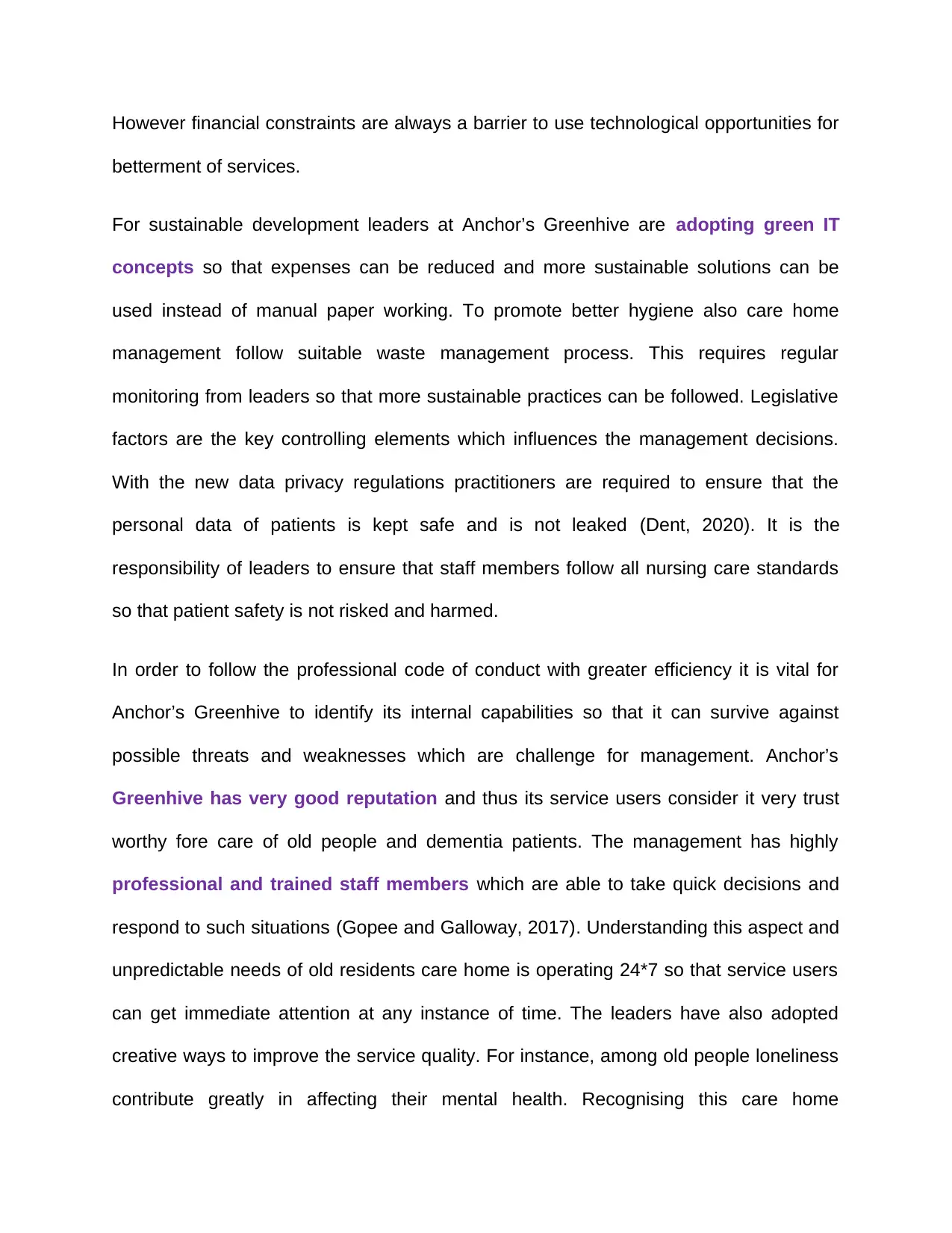
However financial constraints are always a barrier to use technological opportunities for
betterment of services.
For sustainable development leaders at Anchor’s Greenhive are adopting green IT
concepts so that expenses can be reduced and more sustainable solutions can be
used instead of manual paper working. To promote better hygiene also care home
management follow suitable waste management process. This requires regular
monitoring from leaders so that more sustainable practices can be followed. Legislative
factors are the key controlling elements which influences the management decisions.
With the new data privacy regulations practitioners are required to ensure that the
personal data of patients is kept safe and is not leaked (Dent, 2020). It is the
responsibility of leaders to ensure that staff members follow all nursing care standards
so that patient safety is not risked and harmed.
In order to follow the professional code of conduct with greater efficiency it is vital for
Anchor’s Greenhive to identify its internal capabilities so that it can survive against
possible threats and weaknesses which are challenge for management. Anchor’s
Greenhive has very good reputation and thus its service users consider it very trust
worthy fore care of old people and dementia patients. The management has highly
professional and trained staff members which are able to take quick decisions and
respond to such situations (Gopee and Galloway, 2017). Understanding this aspect and
unpredictable needs of old residents care home is operating 24*7 so that service users
can get immediate attention at any instance of time. The leaders have also adopted
creative ways to improve the service quality. For instance, among old people loneliness
contribute greatly in affecting their mental health. Recognising this care home
betterment of services.
For sustainable development leaders at Anchor’s Greenhive are adopting green IT
concepts so that expenses can be reduced and more sustainable solutions can be
used instead of manual paper working. To promote better hygiene also care home
management follow suitable waste management process. This requires regular
monitoring from leaders so that more sustainable practices can be followed. Legislative
factors are the key controlling elements which influences the management decisions.
With the new data privacy regulations practitioners are required to ensure that the
personal data of patients is kept safe and is not leaked (Dent, 2020). It is the
responsibility of leaders to ensure that staff members follow all nursing care standards
so that patient safety is not risked and harmed.
In order to follow the professional code of conduct with greater efficiency it is vital for
Anchor’s Greenhive to identify its internal capabilities so that it can survive against
possible threats and weaknesses which are challenge for management. Anchor’s
Greenhive has very good reputation and thus its service users consider it very trust
worthy fore care of old people and dementia patients. The management has highly
professional and trained staff members which are able to take quick decisions and
respond to such situations (Gopee and Galloway, 2017). Understanding this aspect and
unpredictable needs of old residents care home is operating 24*7 so that service users
can get immediate attention at any instance of time. The leaders have also adopted
creative ways to improve the service quality. For instance, among old people loneliness
contribute greatly in affecting their mental health. Recognising this care home
⊘ This is a preview!⊘
Do you want full access?
Subscribe today to unlock all pages.

Trusted by 1+ million students worldwide
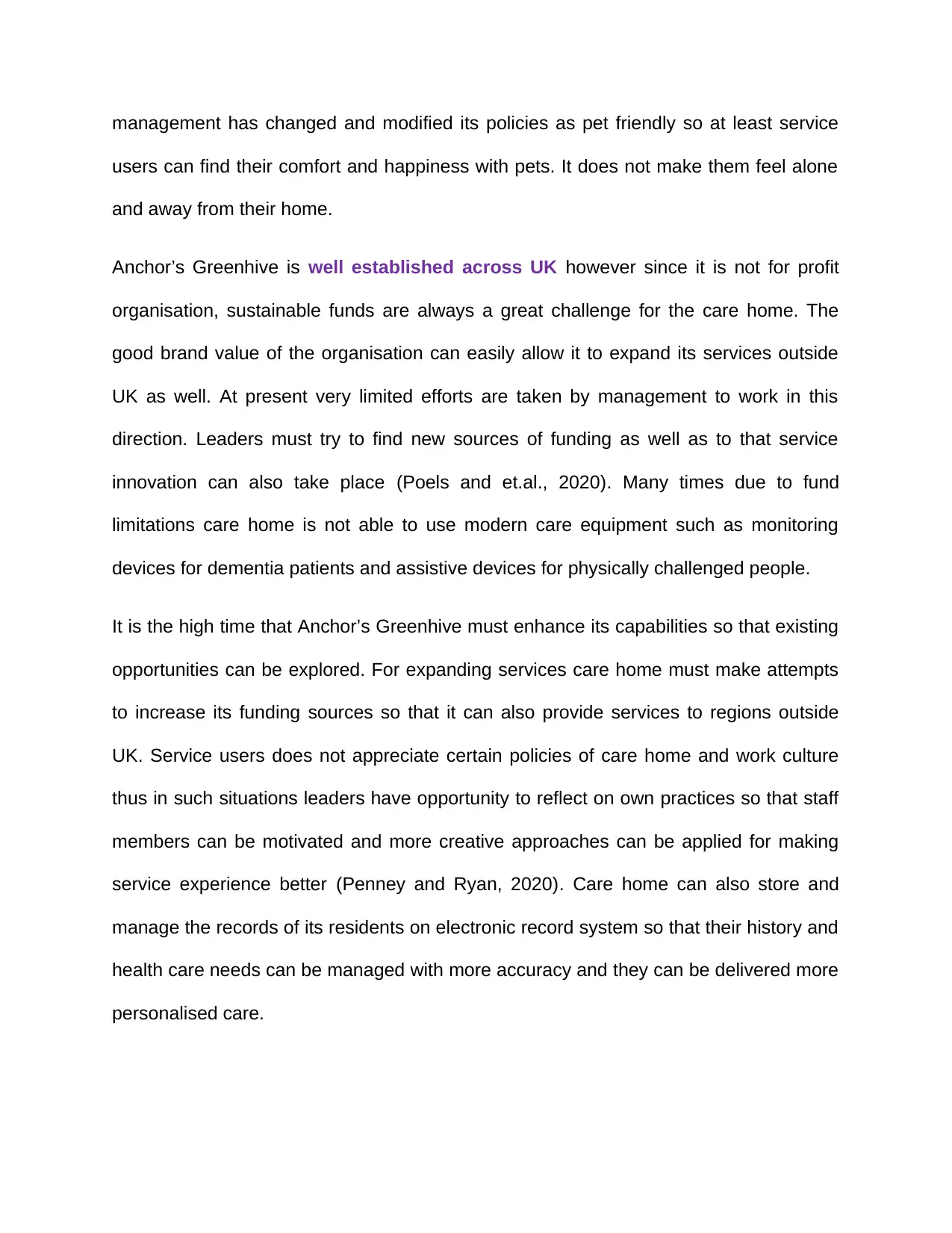
management has changed and modified its policies as pet friendly so at least service
users can find their comfort and happiness with pets. It does not make them feel alone
and away from their home.
Anchor’s Greenhive is well established across UK however since it is not for profit
organisation, sustainable funds are always a great challenge for the care home. The
good brand value of the organisation can easily allow it to expand its services outside
UK as well. At present very limited efforts are taken by management to work in this
direction. Leaders must try to find new sources of funding as well as to that service
innovation can also take place (Poels and et.al., 2020). Many times due to fund
limitations care home is not able to use modern care equipment such as monitoring
devices for dementia patients and assistive devices for physically challenged people.
It is the high time that Anchor’s Greenhive must enhance its capabilities so that existing
opportunities can be explored. For expanding services care home must make attempts
to increase its funding sources so that it can also provide services to regions outside
UK. Service users does not appreciate certain policies of care home and work culture
thus in such situations leaders have opportunity to reflect on own practices so that staff
members can be motivated and more creative approaches can be applied for making
service experience better (Penney and Ryan, 2020). Care home can also store and
manage the records of its residents on electronic record system so that their history and
health care needs can be managed with more accuracy and they can be delivered more
personalised care.
users can find their comfort and happiness with pets. It does not make them feel alone
and away from their home.
Anchor’s Greenhive is well established across UK however since it is not for profit
organisation, sustainable funds are always a great challenge for the care home. The
good brand value of the organisation can easily allow it to expand its services outside
UK as well. At present very limited efforts are taken by management to work in this
direction. Leaders must try to find new sources of funding as well as to that service
innovation can also take place (Poels and et.al., 2020). Many times due to fund
limitations care home is not able to use modern care equipment such as monitoring
devices for dementia patients and assistive devices for physically challenged people.
It is the high time that Anchor’s Greenhive must enhance its capabilities so that existing
opportunities can be explored. For expanding services care home must make attempts
to increase its funding sources so that it can also provide services to regions outside
UK. Service users does not appreciate certain policies of care home and work culture
thus in such situations leaders have opportunity to reflect on own practices so that staff
members can be motivated and more creative approaches can be applied for making
service experience better (Penney and Ryan, 2020). Care home can also store and
manage the records of its residents on electronic record system so that their history and
health care needs can be managed with more accuracy and they can be delivered more
personalised care.
Paraphrase This Document
Need a fresh take? Get an instant paraphrase of this document with our AI Paraphraser
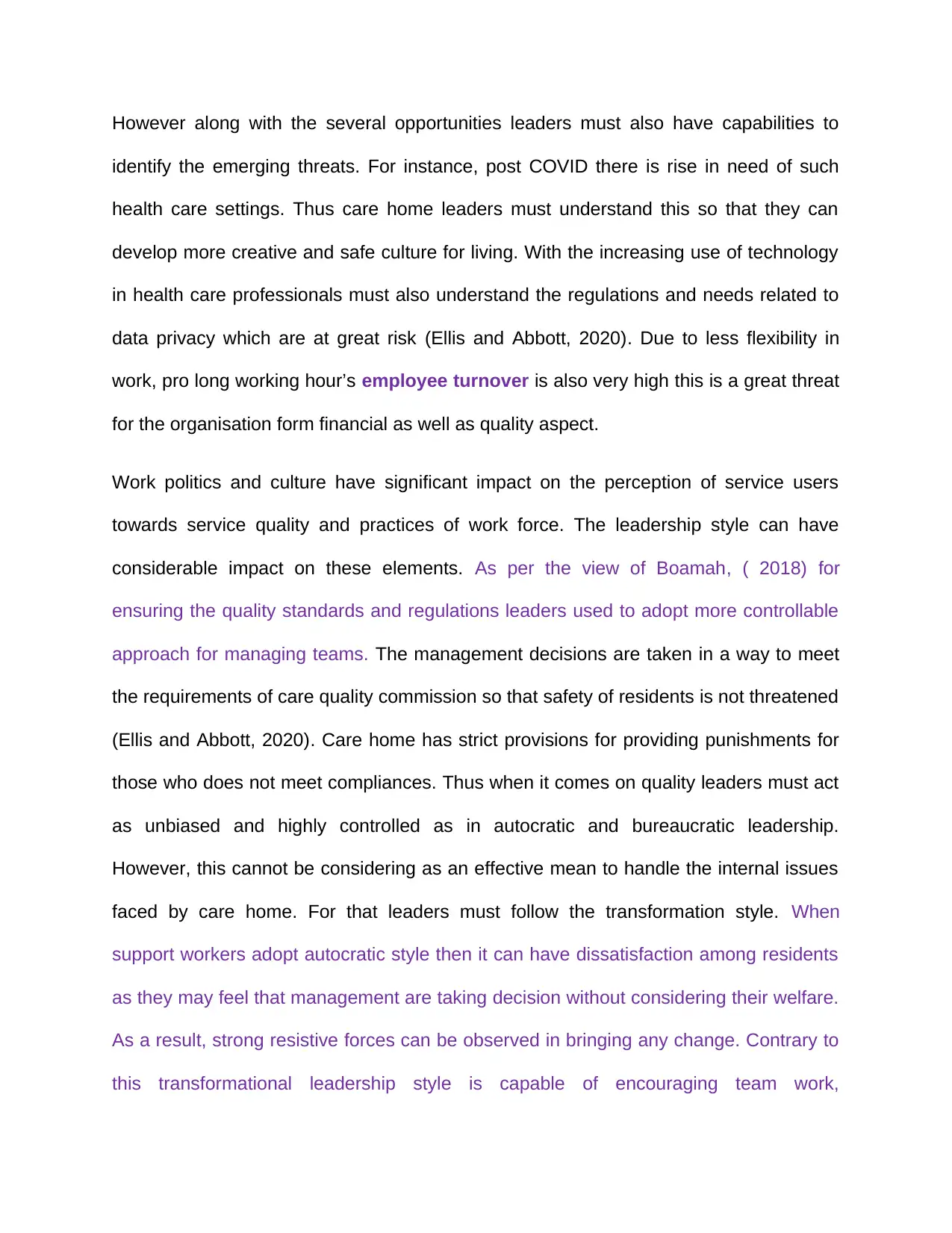
However along with the several opportunities leaders must also have capabilities to
identify the emerging threats. For instance, post COVID there is rise in need of such
health care settings. Thus care home leaders must understand this so that they can
develop more creative and safe culture for living. With the increasing use of technology
in health care professionals must also understand the regulations and needs related to
data privacy which are at great risk (Ellis and Abbott, 2020). Due to less flexibility in
work, pro long working hour’s employee turnover is also very high this is a great threat
for the organisation form financial as well as quality aspect.
Work politics and culture have significant impact on the perception of service users
towards service quality and practices of work force. The leadership style can have
considerable impact on these elements. As per the view of Boamah, ( 2018) for
ensuring the quality standards and regulations leaders used to adopt more controllable
approach for managing teams. The management decisions are taken in a way to meet
the requirements of care quality commission so that safety of residents is not threatened
(Ellis and Abbott, 2020). Care home has strict provisions for providing punishments for
those who does not meet compliances. Thus when it comes on quality leaders must act
as unbiased and highly controlled as in autocratic and bureaucratic leadership.
However, this cannot be considering as an effective mean to handle the internal issues
faced by care home. For that leaders must follow the transformation style. When
support workers adopt autocratic style then it can have dissatisfaction among residents
as they may feel that management are taking decision without considering their welfare.
As a result, strong resistive forces can be observed in bringing any change. Contrary to
this transformational leadership style is capable of encouraging team work,
identify the emerging threats. For instance, post COVID there is rise in need of such
health care settings. Thus care home leaders must understand this so that they can
develop more creative and safe culture for living. With the increasing use of technology
in health care professionals must also understand the regulations and needs related to
data privacy which are at great risk (Ellis and Abbott, 2020). Due to less flexibility in
work, pro long working hour’s employee turnover is also very high this is a great threat
for the organisation form financial as well as quality aspect.
Work politics and culture have significant impact on the perception of service users
towards service quality and practices of work force. The leadership style can have
considerable impact on these elements. As per the view of Boamah, ( 2018) for
ensuring the quality standards and regulations leaders used to adopt more controllable
approach for managing teams. The management decisions are taken in a way to meet
the requirements of care quality commission so that safety of residents is not threatened
(Ellis and Abbott, 2020). Care home has strict provisions for providing punishments for
those who does not meet compliances. Thus when it comes on quality leaders must act
as unbiased and highly controlled as in autocratic and bureaucratic leadership.
However, this cannot be considering as an effective mean to handle the internal issues
faced by care home. For that leaders must follow the transformation style. When
support workers adopt autocratic style then it can have dissatisfaction among residents
as they may feel that management are taking decision without considering their welfare.
As a result, strong resistive forces can be observed in bringing any change. Contrary to
this transformational leadership style is capable of encouraging team work,
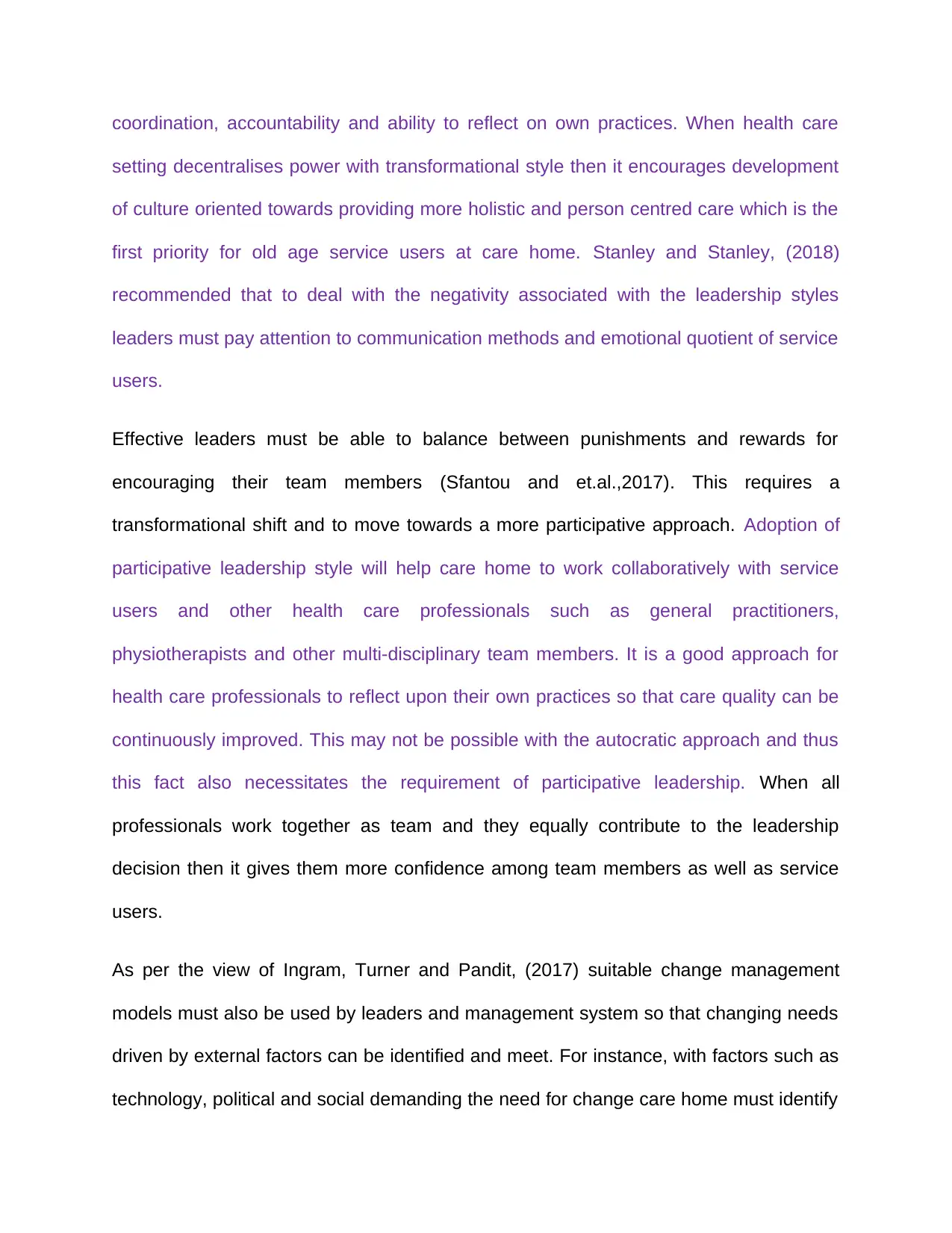
coordination, accountability and ability to reflect on own practices. When health care
setting decentralises power with transformational style then it encourages development
of culture oriented towards providing more holistic and person centred care which is the
first priority for old age service users at care home. Stanley and Stanley, (2018)
recommended that to deal with the negativity associated with the leadership styles
leaders must pay attention to communication methods and emotional quotient of service
users.
Effective leaders must be able to balance between punishments and rewards for
encouraging their team members (Sfantou and et.al.,2017). This requires a
transformational shift and to move towards a more participative approach. Adoption of
participative leadership style will help care home to work collaboratively with service
users and other health care professionals such as general practitioners,
physiotherapists and other multi-disciplinary team members. It is a good approach for
health care professionals to reflect upon their own practices so that care quality can be
continuously improved. This may not be possible with the autocratic approach and thus
this fact also necessitates the requirement of participative leadership. When all
professionals work together as team and they equally contribute to the leadership
decision then it gives them more confidence among team members as well as service
users.
As per the view of Ingram, Turner and Pandit, (2017) suitable change management
models must also be used by leaders and management system so that changing needs
driven by external factors can be identified and meet. For instance, with factors such as
technology, political and social demanding the need for change care home must identify
setting decentralises power with transformational style then it encourages development
of culture oriented towards providing more holistic and person centred care which is the
first priority for old age service users at care home. Stanley and Stanley, (2018)
recommended that to deal with the negativity associated with the leadership styles
leaders must pay attention to communication methods and emotional quotient of service
users.
Effective leaders must be able to balance between punishments and rewards for
encouraging their team members (Sfantou and et.al.,2017). This requires a
transformational shift and to move towards a more participative approach. Adoption of
participative leadership style will help care home to work collaboratively with service
users and other health care professionals such as general practitioners,
physiotherapists and other multi-disciplinary team members. It is a good approach for
health care professionals to reflect upon their own practices so that care quality can be
continuously improved. This may not be possible with the autocratic approach and thus
this fact also necessitates the requirement of participative leadership. When all
professionals work together as team and they equally contribute to the leadership
decision then it gives them more confidence among team members as well as service
users.
As per the view of Ingram, Turner and Pandit, (2017) suitable change management
models must also be used by leaders and management system so that changing needs
driven by external factors can be identified and meet. For instance, with factors such as
technology, political and social demanding the need for change care home must identify
⊘ This is a preview!⊘
Do you want full access?
Subscribe today to unlock all pages.

Trusted by 1+ million students worldwide
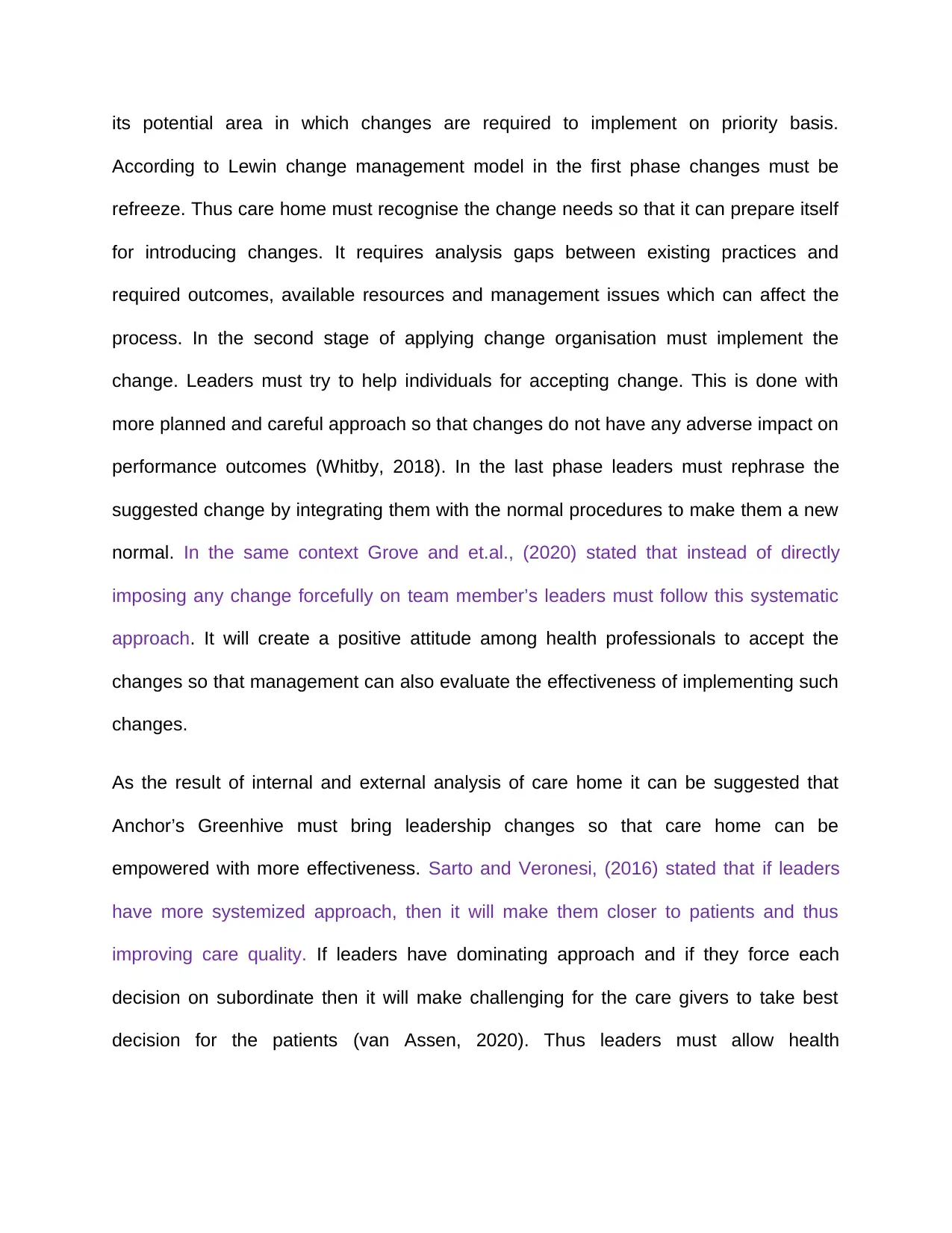
its potential area in which changes are required to implement on priority basis.
According to Lewin change management model in the first phase changes must be
refreeze. Thus care home must recognise the change needs so that it can prepare itself
for introducing changes. It requires analysis gaps between existing practices and
required outcomes, available resources and management issues which can affect the
process. In the second stage of applying change organisation must implement the
change. Leaders must try to help individuals for accepting change. This is done with
more planned and careful approach so that changes do not have any adverse impact on
performance outcomes (Whitby, 2018). In the last phase leaders must rephrase the
suggested change by integrating them with the normal procedures to make them a new
normal. In the same context Grove and et.al., (2020) stated that instead of directly
imposing any change forcefully on team member’s leaders must follow this systematic
approach. It will create a positive attitude among health professionals to accept the
changes so that management can also evaluate the effectiveness of implementing such
changes.
As the result of internal and external analysis of care home it can be suggested that
Anchor’s Greenhive must bring leadership changes so that care home can be
empowered with more effectiveness. Sarto and Veronesi, (2016) stated that if leaders
have more systemized approach, then it will make them closer to patients and thus
improving care quality. If leaders have dominating approach and if they force each
decision on subordinate then it will make challenging for the care givers to take best
decision for the patients (van Assen, 2020). Thus leaders must allow health
According to Lewin change management model in the first phase changes must be
refreeze. Thus care home must recognise the change needs so that it can prepare itself
for introducing changes. It requires analysis gaps between existing practices and
required outcomes, available resources and management issues which can affect the
process. In the second stage of applying change organisation must implement the
change. Leaders must try to help individuals for accepting change. This is done with
more planned and careful approach so that changes do not have any adverse impact on
performance outcomes (Whitby, 2018). In the last phase leaders must rephrase the
suggested change by integrating them with the normal procedures to make them a new
normal. In the same context Grove and et.al., (2020) stated that instead of directly
imposing any change forcefully on team member’s leaders must follow this systematic
approach. It will create a positive attitude among health professionals to accept the
changes so that management can also evaluate the effectiveness of implementing such
changes.
As the result of internal and external analysis of care home it can be suggested that
Anchor’s Greenhive must bring leadership changes so that care home can be
empowered with more effectiveness. Sarto and Veronesi, (2016) stated that if leaders
have more systemized approach, then it will make them closer to patients and thus
improving care quality. If leaders have dominating approach and if they force each
decision on subordinate then it will make challenging for the care givers to take best
decision for the patients (van Assen, 2020). Thus leaders must allow health
Paraphrase This Document
Need a fresh take? Get an instant paraphrase of this document with our AI Paraphraser
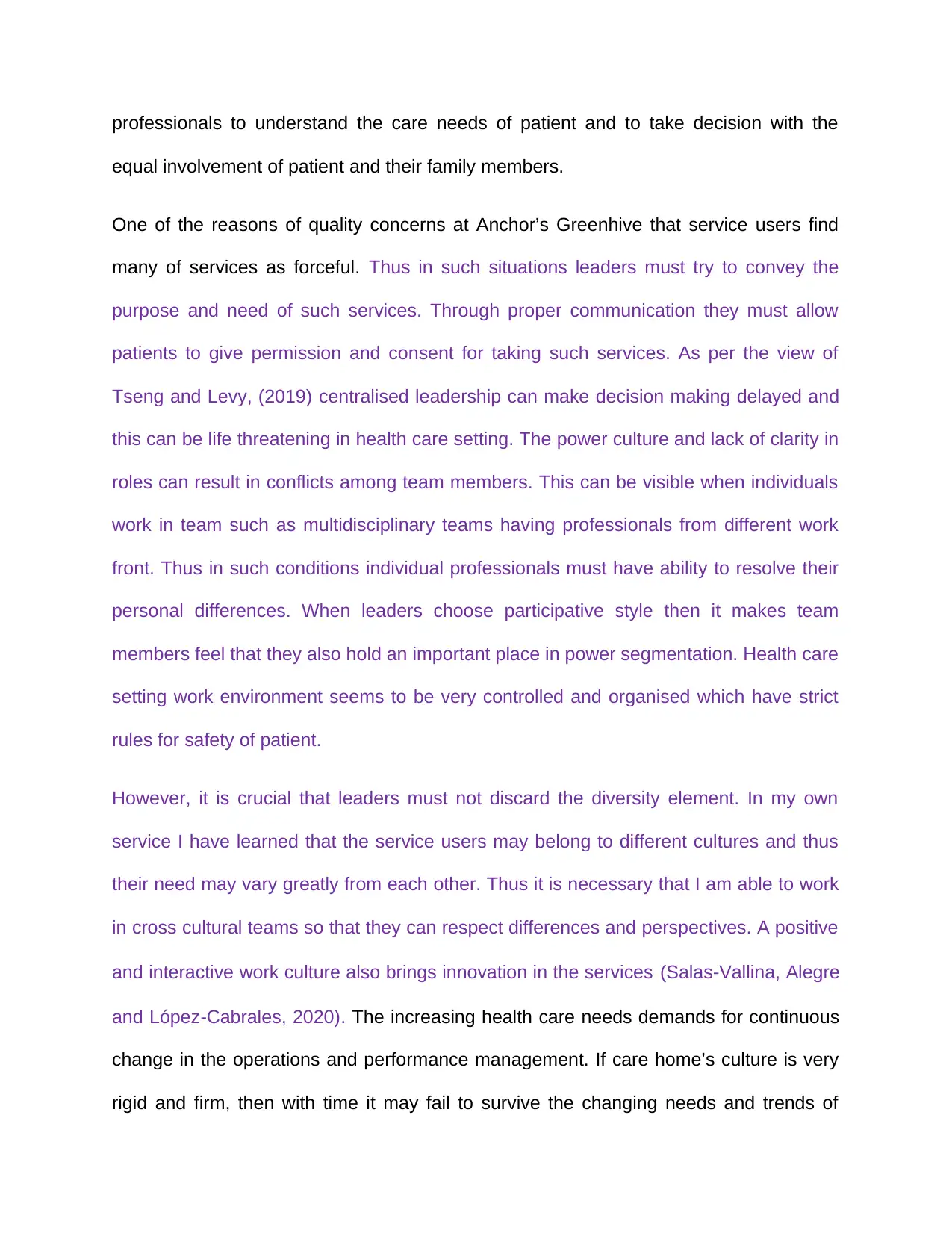
professionals to understand the care needs of patient and to take decision with the
equal involvement of patient and their family members.
One of the reasons of quality concerns at Anchor’s Greenhive that service users find
many of services as forceful. Thus in such situations leaders must try to convey the
purpose and need of such services. Through proper communication they must allow
patients to give permission and consent for taking such services. As per the view of
Tseng and Levy, (2019) centralised leadership can make decision making delayed and
this can be life threatening in health care setting. The power culture and lack of clarity in
roles can result in conflicts among team members. This can be visible when individuals
work in team such as multidisciplinary teams having professionals from different work
front. Thus in such conditions individual professionals must have ability to resolve their
personal differences. When leaders choose participative style then it makes team
members feel that they also hold an important place in power segmentation. Health care
setting work environment seems to be very controlled and organised which have strict
rules for safety of patient.
However, it is crucial that leaders must not discard the diversity element. In my own
service I have learned that the service users may belong to different cultures and thus
their need may vary greatly from each other. Thus it is necessary that I am able to work
in cross cultural teams so that they can respect differences and perspectives. A positive
and interactive work culture also brings innovation in the services (Salas‐Vallina, Alegre
and López‐Cabrales, 2020). The increasing health care needs demands for continuous
change in the operations and performance management. If care home’s culture is very
rigid and firm, then with time it may fail to survive the changing needs and trends of
equal involvement of patient and their family members.
One of the reasons of quality concerns at Anchor’s Greenhive that service users find
many of services as forceful. Thus in such situations leaders must try to convey the
purpose and need of such services. Through proper communication they must allow
patients to give permission and consent for taking such services. As per the view of
Tseng and Levy, (2019) centralised leadership can make decision making delayed and
this can be life threatening in health care setting. The power culture and lack of clarity in
roles can result in conflicts among team members. This can be visible when individuals
work in team such as multidisciplinary teams having professionals from different work
front. Thus in such conditions individual professionals must have ability to resolve their
personal differences. When leaders choose participative style then it makes team
members feel that they also hold an important place in power segmentation. Health care
setting work environment seems to be very controlled and organised which have strict
rules for safety of patient.
However, it is crucial that leaders must not discard the diversity element. In my own
service I have learned that the service users may belong to different cultures and thus
their need may vary greatly from each other. Thus it is necessary that I am able to work
in cross cultural teams so that they can respect differences and perspectives. A positive
and interactive work culture also brings innovation in the services (Salas‐Vallina, Alegre
and López‐Cabrales, 2020). The increasing health care needs demands for continuous
change in the operations and performance management. If care home’s culture is very
rigid and firm, then with time it may fail to survive the changing needs and trends of
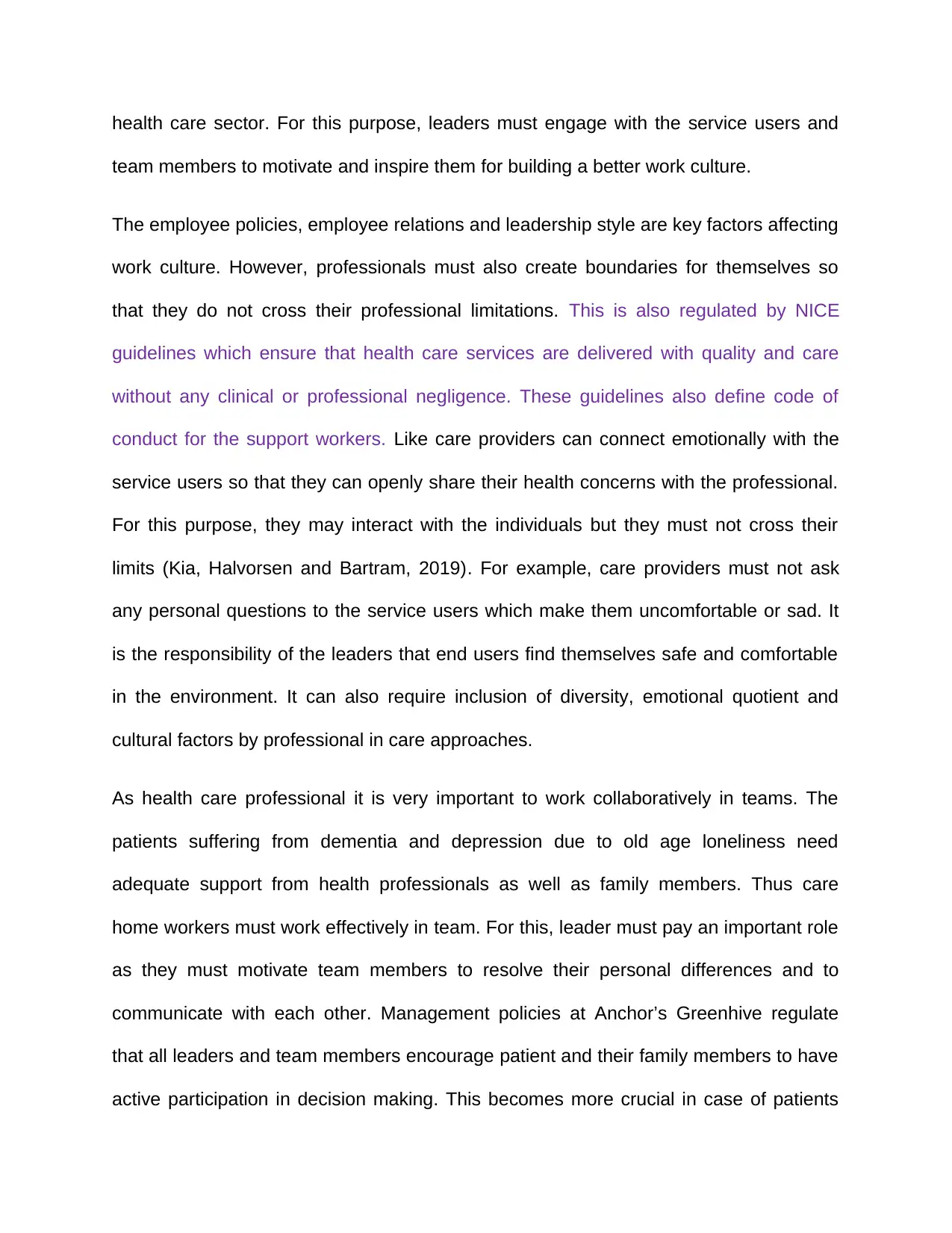
health care sector. For this purpose, leaders must engage with the service users and
team members to motivate and inspire them for building a better work culture.
The employee policies, employee relations and leadership style are key factors affecting
work culture. However, professionals must also create boundaries for themselves so
that they do not cross their professional limitations. This is also regulated by NICE
guidelines which ensure that health care services are delivered with quality and care
without any clinical or professional negligence. These guidelines also define code of
conduct for the support workers. Like care providers can connect emotionally with the
service users so that they can openly share their health concerns with the professional.
For this purpose, they may interact with the individuals but they must not cross their
limits (Kia, Halvorsen and Bartram, 2019). For example, care providers must not ask
any personal questions to the service users which make them uncomfortable or sad. It
is the responsibility of the leaders that end users find themselves safe and comfortable
in the environment. It can also require inclusion of diversity, emotional quotient and
cultural factors by professional in care approaches.
As health care professional it is very important to work collaboratively in teams. The
patients suffering from dementia and depression due to old age loneliness need
adequate support from health professionals as well as family members. Thus care
home workers must work effectively in team. For this, leader must pay an important role
as they must motivate team members to resolve their personal differences and to
communicate with each other. Management policies at Anchor’s Greenhive regulate
that all leaders and team members encourage patient and their family members to have
active participation in decision making. This becomes more crucial in case of patients
team members to motivate and inspire them for building a better work culture.
The employee policies, employee relations and leadership style are key factors affecting
work culture. However, professionals must also create boundaries for themselves so
that they do not cross their professional limitations. This is also regulated by NICE
guidelines which ensure that health care services are delivered with quality and care
without any clinical or professional negligence. These guidelines also define code of
conduct for the support workers. Like care providers can connect emotionally with the
service users so that they can openly share their health concerns with the professional.
For this purpose, they may interact with the individuals but they must not cross their
limits (Kia, Halvorsen and Bartram, 2019). For example, care providers must not ask
any personal questions to the service users which make them uncomfortable or sad. It
is the responsibility of the leaders that end users find themselves safe and comfortable
in the environment. It can also require inclusion of diversity, emotional quotient and
cultural factors by professional in care approaches.
As health care professional it is very important to work collaboratively in teams. The
patients suffering from dementia and depression due to old age loneliness need
adequate support from health professionals as well as family members. Thus care
home workers must work effectively in team. For this, leader must pay an important role
as they must motivate team members to resolve their personal differences and to
communicate with each other. Management policies at Anchor’s Greenhive regulate
that all leaders and team members encourage patient and their family members to have
active participation in decision making. This becomes more crucial in case of patients
⊘ This is a preview!⊘
Do you want full access?
Subscribe today to unlock all pages.

Trusted by 1+ million students worldwide
1 out of 22
Related Documents
Your All-in-One AI-Powered Toolkit for Academic Success.
+13062052269
info@desklib.com
Available 24*7 on WhatsApp / Email
![[object Object]](/_next/static/media/star-bottom.7253800d.svg)
Unlock your academic potential
Copyright © 2020–2025 A2Z Services. All Rights Reserved. Developed and managed by ZUCOL.





